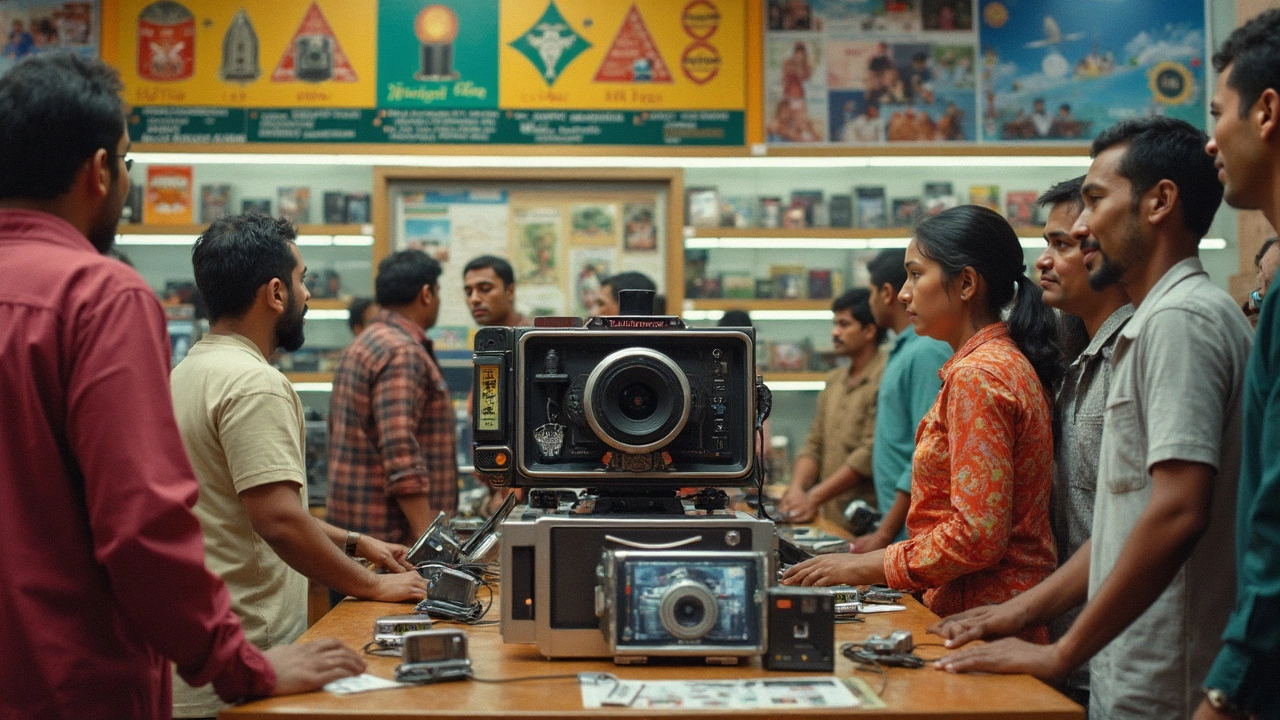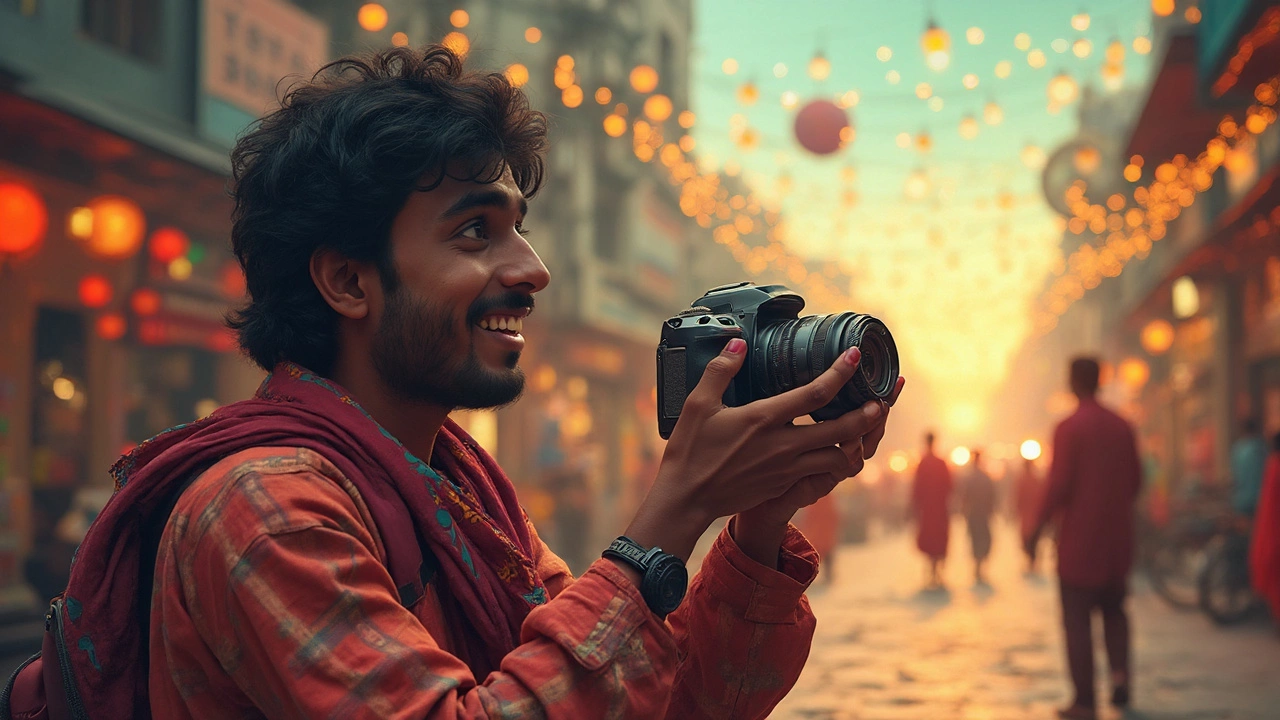Who Sold the First Digital Camera?
 Apr, 15 2025
Apr, 15 2025
Ever wondered who had the vision to sell the first digital camera? Kodak might be the brand that pops into many minds, but it was Fuji that took the leap in 1988. The Fuji DS-1P is often credited as the first fully digital camera, although you'll find the Kodak electronic camera prototype floating around 1975. But the Fuji team was the first to bring this tech to market, which was a pretty bold move at a time when film was still king.
What was so special about that camera? Well, the Fuji DS-1P used a memory card to store images digitally, a groundbreaking feature then. But the tricky part was convincing the world that digital was the future. Film photography had been around for what felt like forever, and people were comfortable with the quality and process. It was like trying to get folks to believe that email would one day overshadow postal mail back in '95.
- The Invention of the First Digital Camera
- The Pioneering Sale and Marketing Strategy
- Impact on Photography World
- Technological Advancements
- Future Prospects in Digital Photography
The Invention of the First Digital Camera
The journey to invent the first digital camera was quite the adventure. Back in 1975, an engineer named Steven Sasson working at Kodak put together the prototype of what would change how we capture memories forever. This initial device looked more like a toaster than the sleek cameras we have now!
Despite its bulky appearance, the technology behind it was revolutionary. Sasson's first prototype used a CCD image sensor and a temporary storage system to capture and display black-and-white photos. While that doesn't sound like much today, it was a brand-new concept at the time. Here's a head-spinning fact: this first machine took 23 seconds to capture a single image! But that was the first step into what would become the world of digital photography.
"The camera was a klunky-looking device, but it was a proof that we can take pictures without film," Steven Sasson said about his invention in an interview reflecting on those early days.
For a long time, Kodak kept this new tech under wraps, seeing the potential but fearing the impact it’d have on their film sales. They had the vision but hesitated to jump in feet first. Eventually, other companies sniffed the opportunity, with Fuji being the first to actually sell a digital camera to the public in the late '80s.
This early digital camera didn’t flood the market right away. It’s a classic case of early bird gets the worm, but the persistence of digital technology eventually took off, pushing cameras in a direction nobody had fully imagined in those early days.
The Pioneering Sale and Marketing Strategy
So, how did Fuji convince everyone to make the leap into the world of digital photography? When they launched the DS-1P, they didn't just place it quietly on the shelves. Nope, they went all out with a marketing strategy that was as bold as the tech itself. They had to assure photographers that this digital camera was not only a worthy replacement for film but also offered something new and exciting.
Fuji's approach centered around a few key strategies. First, they targeted professional photographers who were looking for speed and efficiency. In the fast-paced industry of news and photojournalism, waiting for film processing was a major drawback. Fuji emphasized that their camera eliminated this issue, making getting images out to publications much faster.
Next, they highlighted the cost efficiency. No more buying rolls of film or spending on developing—just snap and go. Fuji made it clear that while the initial investment might seem steep, the long-term savings were a no-brainer. They also put effort into hands-on demonstrations, allowing potential buyers to feel the magic firsthand. Experiencing the ease and instant results of the digital space can do wonders in swaying opinions.
And here's a fun tidbit—Fuji's successful launch opened the door for competitors to jump into the digital market, leading to some rapid advancements in the camera evolution. Within a few years, the digital photography arena was buzzing with innovation and competition, pushing technology forward in leaps and bounds.
This blend of savvy marketing and real-world benefits demonstrated by Fuji not only sent ripples through the digital photography universe but ultimately laid the groundwork for the digital cameras we all know and love today.

Impact on Photography World
When the first fully digital camera hit the market, it was like opening the gates to a whole new playground for photography enthusiasts. Why wait hours or even days for film to develop when you could view your shots instantly? This shift didn't just slap the competition of film cameras; it changed the way people approached photography itself.
For professional photographers, digital cameras became a blessing and a challenge. The shift meant no more costly film rolls, but it also required adapting to new editing software and storage methods. Now, photographers had to become tech-savvy, learning how to manage and edit digital files to keep up with the changing times.
The real winner here was convenience. With a digital camera, taking hundreds of photos without worrying about wasting film became the new norm. This accessibility fueled the rise of amateur photography. Suddenly, anyone with a camera could experiment without barriers, leading to an explosion of creativity worldwide.
This revolution didn't just affect users but camera manufacturers too. The arrival of digital cameras thrust companies like Nikon, Canon, and Sony into a race to outdo each other on features like megapixels, zoom capabilities, and battery life. Competition led to terrifyingly fast improvements in technology, giving us the mind-blowing specs we see today.
And statistics back it up. By 2020, digital camera sales had far outpaced film, as seen in the numbers below:
| Year | Digital Camera Sales (Millions) | Film Camera Sales (Millions) |
|---|---|---|
| 2000 | 5 | 85 |
| 2010 | 121 | 21 |
| 2020 | 176 | 5 |
In short, the first digital camera sale wasn't just about selling a product; it was about redefining the essence of photography itself. And if you think about it, we're still riding that wave of change today.
Technological Advancements
Digital cameras have come a long way since the first models hit the market in the late '80s. Back then, the focus was on shifting from film to digital storage, and every year brought new tweaks and improvements. The first digital camera might have had pixel counts you wouldn't even consider acceptable today, but it was a start.
Fast forward to the present, and digital cameras boast some insanely good features. Today, cameras not only capture stunning high-resolution images but also offer advanced technologies like image stabilization and sensor-shift optical stabilization, which take out any shake while you click. And let's not forget autofocus systems that can lock onto a subject's eye within nanoseconds.
One of the biggest tech leaps was the introduction of mirrorless cameras. They dropped the clunky mirror component found in traditional DSLRs, making cameras lighter and more compact without sacrificing quality. This was a game-changer for enthusiasts and pros alike who needed to haul gear without breaking their bodies.
When it comes to storage, the proverbial 'sky is the limit' now. Current SD cards have massive capacities compared to the 16 MB cards we used to think were hot stuff. You'll find gigabyte-heavy options that support fast data transfer speeds, perfect for 4K videos or burst shooting.
| Year | Key Advancement |
|---|---|
| 1991 | First professional DSLR introduced by Kodak |
| 1999 | Nikon's first professional DSLR with a truly usable interface |
| 2004 | Canon launched improved image processing with the DIGIC II |
| 2013 | Sony's full-frame mirrorless cameras hit the scene |
The evolution didn't stop there. With developments in cloud storage and sharing, photographers can easily share their work globally in a jiffy. Cameras now often come with Wi-Fi and Bluetooth, allowing for instant transfer of photos and videos to other devices.
And for the environmentally conscious, many brands are seriously focusing on making their products more sustainable. Manufacturers are considering everything from eco-friendly packaging to creating cameras that consume less energy. It's a neat nod to the planet from an industry known for innovation.

Future Prospects in Digital Photography
Digital photography has come a long way since its start, and the future looks pretty exciting. We're not just talking about improved megapixels or better zoom. There's AI and machine learning hustling to make your photos picture-perfect with minimal effort.
First off, let's chat about AI. It’s getting increasingly involved in camera tech, handling everything from autofocus to real-time editing. Think of it as having a smart assistant in your camera, helping you snap that perfect pic without too much fuss. What's cool is that AI can analyze scenes to adjust settings like exposure or focus automatically, making it easier than ever to photograph like a pro.
The rise of computational photography is a big deal, especially with smartphones already using it to enhance photo quality. It'll keep making digital cameras more intuitive and powerful, closing the gap between traditional cameras and smartphone capabilities. Imagine a future where your camera could generate enhanced images with the click of a button!
Let's not forget about connectivity. Cameras are now smarter and always connected, allowing photographers to upload images straight to the internet or social media platforms. This trend will likely evolve, with features enabling seamless integration with digital ecosystems, virtual reality, and augmented reality.
And for the data enthusiasts, here's a quick peek at camera sale trends:
| Year | Global Sales (Million Units) |
|---|---|
| 2020 | 13.4 |
| 2021 | 15.6 |
| 2022 | 18.9 |
With sales on the rise, manufacturers are focused on crafting innovative features to keep pace with growing consumer expectations.
Technological developments aside, we're also seeing a push towards eco-friendly cameras. Companies are looking at recyclable materials and energy-efficient gadgets, reducing the carbon footprint while still delivering top-notch experiences.
In short, the future of digital photography is about making cameras smarter, more connected, and environmentally friendly. If you're a photography enthusiast, buckle up—it's an exciting ride ahead!